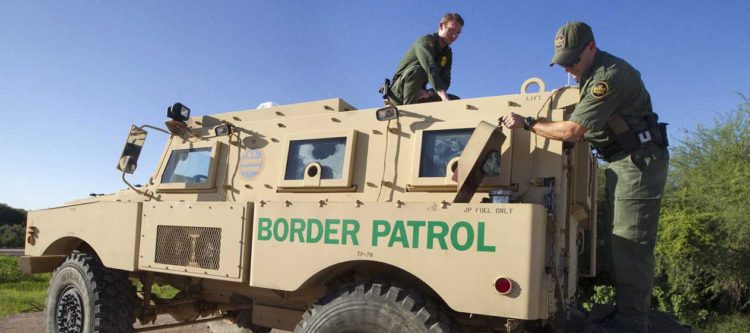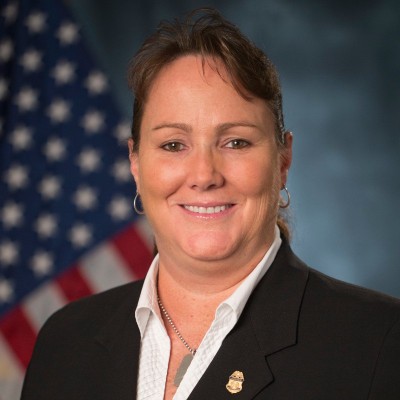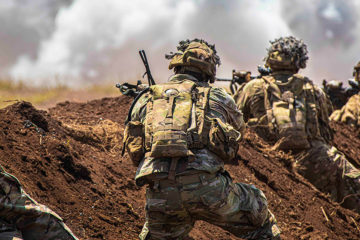Chief Carla Provost on the role of communications in keeping Border Patrol agents safe

Border Patrol agents are often isolated – with miles separating them from their closest allies and backup. They also operate in regions where cellular networks are scarce, radio service can be spotty, and communications between agents can be challenging at best.
To learn more about the life of a Border Patrol agent and the struggles they face, we spoke with someone that knows the agency better than anyone – former Chief and the first female head of the United States Border Patrol, Carla Provost.
During our discussion, we asked Chief Provost about her history in the agency, the challenges that off-the-grid operations create for Border Patrol agents, and the role that new technologies can play in keeping agents connected, safe, and accountable.
Here is what she had to say:
 The Last Mile (TLM): Can you tell our readers a bit about your role and responsibilities during your time at the CBP?
The Last Mile (TLM): Can you tell our readers a bit about your role and responsibilities during your time at the CBP?
Chief Provost: I worked in federal law enforcement for just over 25 years. I didn’t spend that entire time with U.S. Customs and Border Protection (CBP), obviously, since [the agency] wasn’t created until 2003. However, I spent the majority of my career in the U.S. Border Patrol and what was previously the U.S. Immigration and Naturalization Service (INS).
I began my career in 1995 stationed in lovely Douglas, AZ, which is located in the southeast corner of Arizona. Because of its geography and remote location, it became a hotbed for illegal activity in the 90s. Early in my career, I served as a frontline agent, firearms instructor and on bicycle patrol. Throughout my career, I was often stationed at locations that were hotbeds for illegal activity – drug smuggling and illegal entries.
Towards the end of my career at the Border Patrol, I was promoted to the Deputy Chief in the El Paso, TX, sector. In El Paso, I had the opportunity to work with my good friend and colleague, Scott Luck, for two years – he was Chief and I was his Deputy Chief. I later became the Chief in the El Centro region, an area in California with approximately 1,200 agents.
After two years as the Chief in El Centro Sector, Scott Luck called me up to Washington, DC, where I began my tenure in the CBP’s Office of Professional Responsibility. I did that job for more than a year before becoming the Deputy Chief of the Border Patrol in 2016. I was quickly named the Acting Chief of the CBP in 2017 before being promoted to Chief of the Border Patrol in 2018. I retired at the end of January 2020, having had the opportunity to serve across the southwest border as well as seeing the national perspective while working in D.C.
TLM: You were the first female chief in the history of the USBP. Tell us about this unique journey and the challenges or obstacles you conquered on your way up the ladder and as you ran the agency.
Chief Provost: The Border Patrol is approximately 5 percent female, which is low for law enforcement. Most law enforcement agencies are approximately 20 percent female.
While it’s a bit of a boy’s club, once you’re in, you’re in – regardless of gender.
As a result, I didn’t hit a lot of obstacles throughout my career. I was welcomed in. I always felt like I was a part of the team. Once you prove yourself, show that you can do the job, and illustrate that you’re a part of that team, you’re not a female Border Patrol agent or a male Border Patrol agent, you’re just a Border Patrol agent.
Border Patrol agents want to know that the people in authority have experienced what they have, and that they have an understanding of what life is like on the ground. I made sure – as I continued through my career – that I touched as many positions as I possibly could and didn’t skip anything. It’s important to see the station perspective and the national perspective. So, when I was named the Chief of the Border Patrol at a pretty tough time for our men and women, I was able to be a voice for the men and women on the front lines. I had a good understanding of what they were going through by touching all of those roles as I came up throughout my career.
TLM: While you were overseeing the agency, was there ever any time when off-grid communications created challenges for the agency? What problems can a lack of communications create for CBP personnel in the field?
Chief Provost: Off-Grid communications were definitely an ongoing challenge. No two Border Patrol stations or regions are quite alike. Each Border Patrol Sector has its own challenges. Let’s say you’ve been stationed in El Centro, the terrain and the challenges there are different from any other location on the southern border. And the northern border is completely different from the southern border, with its own challenges. The remoteness on the longer, northern border can be even more extreme.
In regions with heavily mountainous, treacherous terrain agents can be faced with limited or no connectivity. Line of sight radio communications don’t always work, and there are no cellular networks in many of these extremely remote locations. When you are working by yourself in a treacherous location, and your closest backup is 20-30 miles away, and you can’t communicate with anyone, you’re isolated and facing dangerous situations alone.
If you haven’t been to these different locations along the border, you can’t truly understand just how extreme of a challenge communication is for the agency. And that has, unfortunately, resulted in some tragedies.
“The agency was struggling to get technology into the hands of the frontline men and women because it didn’t have the systems and processes necessary to identify the right technologies and deploy them quickly…Prior to INVNT, it was frustrating for the agents on the frontline. It would often take the organization two or three years to actually get technology out and into the hands of the men and women that needed it…” – Chief Provost
Sadly, back in 2012, the Border Patrol experienced a blue-on-blue situation where we lost an agent. That was a huge tragedy, and a lack of communications was a factor in that situation. Having the right communications technologies can be essential to being able to identify if you are dealing with an adversary or you are dealing with another law enforcement professional. But in remote locations – such as Wellton Arizona – where the majority of the area of responsibility is a national wildlife refuge, and the region is very mountainous and surrounded by desert valleys – communications are not always available.
Criminals know that the Border Patrol has connectivity issues in certain areas, and they concentrate their activities in those regions. And it’s not just the southern border that has a problem with this. The vastness of the northern border provides its own challenges.
A phenomenon that we’ve been dealing with over the last decade or so has been the mass migration of families crossing the border and needing rescue. On both the southern and northern border, the Border Patrol Search, Trauma, and Rescue Unit (BORSTAR), which is specially trained in rescue missions, has to traverse treacherous, remote terrain to save lives and rescue migrants that are attempting to enter our country through remote locations between border crossings.

TLM: Your time at the CBP saw the creation of an Innovation Team (INVNT). What was the catalyst for starting this team, and what challenges was the CBP looking for them to address? How does INVNT drive value to the front line operators of USBP?
Chief Provost: The agency was struggling to get technology into the hands of the frontline men and women because it didn’t have the systems and processes necessary to identify the right technologies and deploy them quickly. And that’s where INVNT was critical and was desperately needed.
Prior to INVNT, it was frustrating for the agents on the frontline. It would often take the organization two or three years to actually get technology out and into the hands of the men and women that needed it to support their operations. INVNT changed that.
Bringing that “boots on the ground” knowledge to the table – creating a joint team of operators and technology professionals – helped bring the requirements together with the existing technologies. The team was able to get solutions into the hands of frontline men and women quickly so that they could deploy, operate, and give feedback about those solutions.
“Sadly, back in 2012, the Border Patrol experienced a blue-on-blue situation where we lost an agent. That was a huge tragedy, and a lack of communications was a factor in that situation.” – Chief Provost
What made INVNT so effective was having agents in the group working hand-in-hand with the people leading it – including its founder, Ari Schuler, and his eventual replacement, Chris Pietrzak. In fact, Chris Pietrzak is a career Border Patrol agent with 22 years of experience.
And it’s essential to get new technologies into the field quickly because the criminal element that is working against Border Patrol agents is constantly innovating. They don’t have the same rules and regulations that the federal government has when it comes to technology procurement and acquisition. Frontline agents were behind the curve – being out-innovated by criminals. INVNT turned the tide for the frontline agents.
TLM: Tell us about the challenges of balancing operations in a dangerous environment, but also ensuring agents are held accountable for their actions. Can technology play a role in this?
Chief Provost: Technology plays a bigger role in holding law enforcement personnel accountable now than it ever has.
Nobody wants a bad officer or bad agent. We all want that bad officer off the streets. Technology is key to protecting the men and women that wear the uniform, as well as those that they serve, whether it be through body-worn cameras, or location tracking and messaging apps that can be used entirely off the grid. Situational awareness technologies can ensure that the location of law enforcement personnel is known at all times, which protects the officer as well as the public they serve.
Organizations like the Border Patrol are doing a better job of leveraging technology for responsibility, accountability, and transparency for law enforcement. I think we’re moving in the right direction, but there are still so many other opportunities for technology that we have yet to explore.
TLM: In the past, The Last Mile has explored some of the specific ways new communications technologies could be utilized on the northern and southern borders. Are mobile mesh networking solutions something that the CBP has explored in the past? Do you see the potential for technologies like these on the border in the future?
Chief Provost: When I was the interim patrol agent in charge in Nogales, we had agents get into a shootout with drug smugglers outside of Nogales. In that particular region, the agents had limited ability to retreat because of different mountain ranges. It was a very dangerous situation. Then there was the situation where an agent was murdered by a “rip-off” crew operating in a remote location near Tucson.
All the way back to the early days of the Border Patrol, there have been situations where knowing where your men and women are and being able to communicate with them would make them safer. Technologies like TAK and mesh networks can deliver that situational awareness for the safety of agents. That is absolutely critical as the cartels further leverage technology to support their efforts. The Border Patrol needs to ensure that law enforcement has similar technology – or better technology – than the criminals.
“There were multiple situations in my career where the Border Patrol had to work with other state, local, and federal organizations. Interoperability has been a critical issue because different agencies operate with different types of technology…systems like TAK combined with mobile mesh networking can help solve this interoperability problem.” – Chief Provost
I think mobile mesh networks are certainly the wave of the future and they can help deliver communications to Border Patrol agents in the remote locations in which they operate. The potential benefits of mobile mesh networks have led the Border Patrol to bring some mobile mesh radios onboard in the past. I certainly anticipate they will continue to expand the adoption of mobile mesh into the future.
TLM: How often does the CBP need to work with other government organizations and agencies? What impact does interoperability have on communications in these scenarios?
Chief Provost: There were multiple situations in my career where the Border Patrol had to work with other state, local, and federal organizations. Interoperability has been a critical issue because different agencies operate with different types of technology and different radio systems.
Going forward, systems like TAK combined with mobile mesh networking can help solve this interoperability problem. All responders will most likely have a cell phone or smart device on them – whether it’s their own personal device or issued by their agency. Making it so that those devices can enable communications and situational awareness – even when cellular networks aren’t available – can ensure that interoperable communication is possible in emergency scenarios, even off-grid.







No Comment